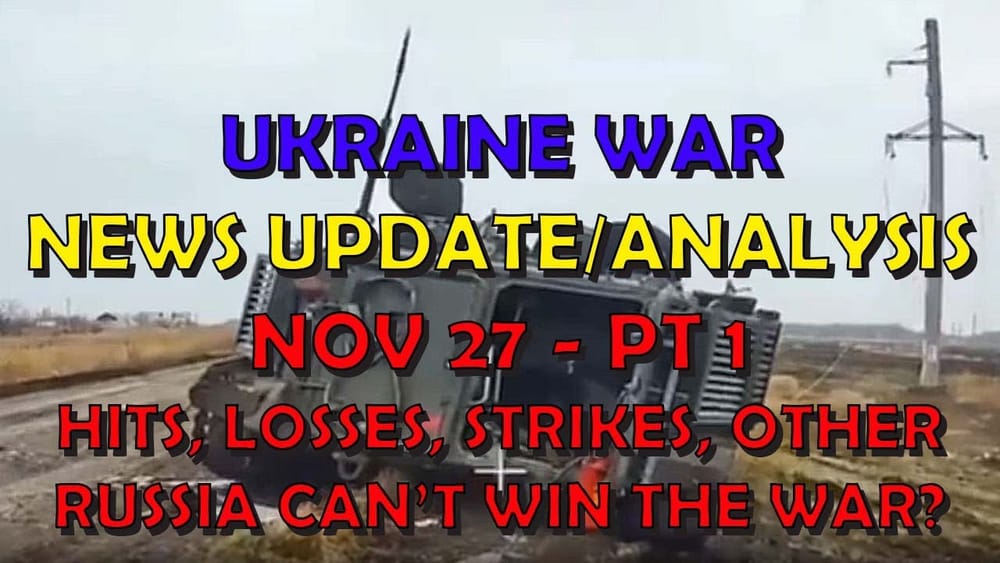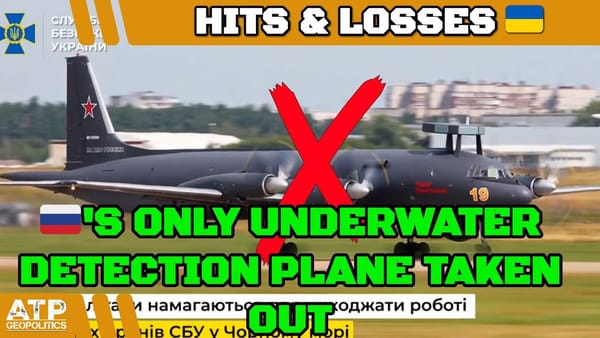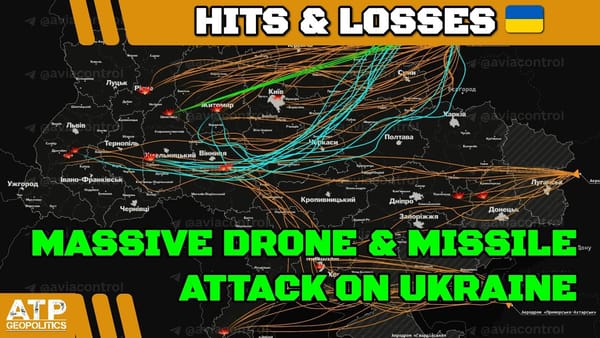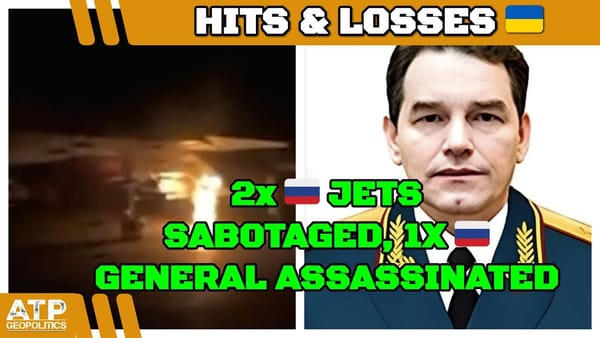Ukraine War Update BUMPER NEWS: Pt 1 - Overnight & Other News, Russia Can't Win the War?
Table of Contents 📖
"They physically can't win this war and suffer the consequences of demobilization. They have to keep the war going."
Hello Team
🎦 00:00-02:53⏩
Jonathan starts the video with his usual welcome, acknowledging his fatigue and the challenges of consistently producing content. He is both concerned and cautiously optimistic about the situation in Ukraine, highlighting potential turning points:
- European nations, including the UK, are showing increased willingness to support Ukraine.
- South Korea's potential involvement could also be significant.
- The Ukrainian arms industry is receiving substantial investments.
- Talk of a Ukrainian counteroffensive coincides with Russia's exhaustion and potential economic crisis.
- The upcoming Trump administration's intention to force negotiations could create opportunities if Ukraine is on the offensive.
He acknowledges the emotional rollercoaster and the need to analyze the available data to understand the complex situation.
Return to top⤴️
🪦 DISCLAIMER FOR GENERAL STAFF LOSSES DATA
- These are real people with real lives and real families who love them. Don’t let the numbers sap your humanity.
- These numbers probably aren’t accurate but they’re the best we have and we don’t need them to be accurate to be indicative of patterns of activity.
- All losses are estimates. Losses cannot be counted with accuracy because of the conditions on the ground.
- Both sides would see it to be of their advantage to minimize their own losses maximize the other side’s losses.
- Neither side releases their losses but we have enough transparency from the Ukrainian side to have confidence in they are indicative.
- Personnel losses are hard to count. If a soldier gets injured, heals up, and returns to the front line only to get injured again, is that one loss or two? Also, how to deal with losses from PMC’s or soldiers fighting with RF from occupied territories?
- Equipment losses are hard to count. If an AA complex involves several parts and one part gets disabled, is that a loss, or a fraction of a loss? If a tank gets disabled, repaired, back into the fight, then disabled again, is that one lost tank or two?
- All recorded losses are vulnerable to multiple reporting. We have already seen numerous cases of multiple drones in the air reporting the same loss from different angles as multiple engagements.
- Losses are not always reported on the same day they occurred. It is frequent that drone losses are reported at least 24 hours after other terrestrial equipment losses. Certain losses may not be reported for days or weeks for military intelligence reasons.
General Staff Figures and Visual Confirmation of Losses
🎦 02:53-08:30⏩
Jonathan analyzes the latest Ukrainian General Staff figures, noting significant Russian losses:
- Personnel: 1,580 (very high)
- Tanks: 14 (above average)
- Troop-carrying AFVs: 48 (extremely high)
- Artillery systems: 24 (above average)
- Vehicles and fuel tanks: 84 (very high)
He emphasizes that video evidence supports these figures, indicating heightened activity on the front lines. He then examines Andrew Perpetua's list of visually confirmed losses from two days prior (November 25th):
- Personnel: 97
- Other equipment: Significant losses of artillery, tanks (mostly Soviet-era), IFVs, Bradleys, BMPs, APCs, MRAPs, civilian vehicles, and even a "battle loaf" (a modified Scooby-Doo van).
Jonathan highlights a trend of increasing Russian personnel losses based on visual data. He discusses the difficulty of estimating personnel losses due to the limitations of visual confirmation and the macabre nature of counting casualties. He believes Russian losses are considerably higher than Ukrainian losses, although precise quantification is challenging.
Return to top⤴️
The Economist's Casualty Estimates and Challenges of Quantification
🎦 08:30-13:55⏩
Jonathan discusses The Economist's July 2024 estimates of war casualties:
- Russian troops: 106,000-140,000 killed in action (estimated up to June 21st, 2024).
- Ukrainian soldiers: At least 60,000-100,000 killed in action.
- Injured Ukrainian soldiers: 400,000.
Jonathan emphasizes that these estimates don't include civilian deaths and are likely conservative given the intensity of fighting in recent months. He reflects on the inherent difficulty in estimating casualties accurately, acknowledging potential biases and the limitations of relying on Ukrainian claims. While intelligence agencies have access to satellite imagery, their primary source of information is likely still Ukrainian reports. Jonathan expresses confidence in the general trends reported by the Ukrainian General Staff but acknowledges uncertainties surrounding exact numbers. He avoids stating total personnel loss figures as the ratio of killed, wounded, POWs, and deserters is unknown.
Return to top⤴️
Fallen Soldiers: Swedish Volunteer and Russian Lieutenant Colonel
🎦 13:55-15:09⏩
Jonathan reports on the death of a 36-year-old Swedish volunteer named Patrick. A former member of the Swedish armed forces with mine-clearing expertise, Patrick joined Ukraine's International Brigade, stating, "This is not right. I can do something." Jonathan expresses sadness over his death, especially given his commitment to fighting for a just cause. He also mentions that James from the YouTube channel "Why Ukraine" has joined a drone unit in Ukraine and wishes him good luck.
Return to top⤴️
Kursk Command Post Strike and North Korean Involvement
🎦 15:09-17:33⏩
Jonathan discusses the aftermath of the Ukrainian Storm Shadow strike on the Kursk command post on November 20th. The attack reportedly resulted in significant casualties, including the death of Russian Lieutenant Colonel Alexander Nikolaevich Gorbachev and injuries to a North Korean general. He references a Financial Times report confirming:
- Several North Korean officers were killed in the strike.
- Thousands of North Korean soldiers are now being deployed to Russia's second line.
- North Korea has supplied Russia with 62 M1989 self-propelled howitzers and 62 updated 240mm MLRS, a significant increase from previous reports.
Jonathan expresses concern about North Korea's growing involvement, arguing that it could prolong the war through attrition. Ukraine lacks the ability to readily replace lost personnel and equipment in the same way that Russia can with North Korean support. He sees this as a potential game-changer if North Korean assistance increases further.
Return to top⤴️
Kursk Equipment Losses
🎦 17:33-19:03⏩
Jonathan analyzes visually confirmed equipment losses in Kursk over the past three weeks:
- Ukraine: 21 tanks lost (approximately one per day).
- Russia: 80 tanks lost (approximately four per day).
This four-to-one loss ratio favors Ukraine but suggests Russia is actively attacking in Kursk. Russian losses are primarily APCs, IFVs, and artillery, indicating their ongoing offensive operations.
Return to top⤴️
Ukrainian Success with Drones and Mines, Russian Disinformation
🎦 19:03-21:26⏩
Jonathan details a successful Ukrainian operation near the Chesif Yar canal:
- The 24th Mechanized Brigade repelled a Russian mechanized assault, destroying seven BMD-4s.
- The Ukrainians achieved this primarily through remote mining and drones.
He emphasizes the critical role of drones and mines in Ukraine's strategy, allowing them to destroy Russian columns before they reach the front line (FLOT). Ukraine's ability to maintain a "buffer zone" where they can utilize these tactics is crucial. He then highlights a case of Russian disinformation where they mistakenly presented images of destroyed Russian T-90M tanks as Ukrainian losses. He finds this amusing, especially as Ukrainian soldiers subsequently published photos of the actual Russian losses.
Return to top⤴️
First Confirmed Loss of a Swedish PV-302 APC
🎦 21:26-22:47⏩
Jonathan addresses a question about the Swedish-supplied PV-302 APCs, noting that they have finally appeared on the loss lists.
- Although these APCs went out of service in 2014, they are still valuable assets.
- Andrew Perpetua believes the first confirmed loss is an abandoned vehicle that likely hit a mine.
Partisan Sabotage of Railway Lines in Kherson Region
🎦 22:47-23:08⏩
Jonathan reports on successful sabotage by the Ateş Partisans:
- They destroyed a relay cabinet in Aleksivka, Kherson region.
- This disrupts the Novoaleksivka-Melitopol railway line, a crucial supply route for Russian troops in Zaporizhia.
Overnight Drone Attacks and Interceptions
🎦 23:08-23:55⏩
Jonathan reports on overnight events, starting with a large-scale drone attack on Ukraine:
- Russia launched 89 drones.
- Ukraine achieved a 100% interception rate, shooting down 36 and causing 48 to become locationally lost.
- Five drones flew off towards Russia or Belarus, but were not considered a threat.
Russian Attacks on Sumy
🎦 23:55-25:28⏩
Jonathan describes Russian attacks on Sumy, citing Tim White's reports:
- One video shows debris from a downed object falling onto a road.
- Another video depicts extensive damage to a parking lot.
- The Kyiv Independent confirms two people died after attacks on a residential building and a kindergarten.
Jonathan condemns the attacks, calling the Russians "bastards" for targeting civilian infrastructure and humanitarian aid points.
Return to top⤴️
Ukrainian Strikes on Crimea and Rostov
🎦 25:28-27:53⏩
Jonathan reports on significant Ukrainian strikes against targets in Crimea and Rostov:
- Crimea:
- Belbek airfield was targeted.
- Explosions reported in Sevastopol.
- A combined attack involved around 40 drones, Neptune missiles, and possibly Storm Shadows.
- Russian sources reported at least two waves of attacks, with a possible third wave anticipated.
- Rostov-on-Don:
- Powerful explosions reported, potentially indicating Ukraine's increased missile capabilities or the use of Neptune missiles.
- Details of damage are still emerging.
Possible Drone Attack on Gazprom Refinery in Bashkiria
🎦 27:53-30:37⏩
Jonathan investigates reports of a large explosion and fire in Salavat, Bashkiria, initially thought to be a drone attack on a Gazprom oil and gas facility. However, conflicting reports suggest it might have been a civilian AN-2 plane flying in a restricted area, subsequently engaged by Russian air defenses. Video footage shows the plane being fired upon with smoke and flames already visible. Jonathan questions the official explanation, finding it odd that a civilian plane would be flying so close to a refinery in a restricted zone. He reiterates his previous concerns about the dangers of flying small aircraft in Russia, as they could easily be mistaken for drones.
Return to top⤴️
Electronic Warfare and Shahid Drone Spoofing
🎦 30:37-32:16⏩
Jonathan discusses Le Monde's report on Ukrainian electronic warfare tactics:
- Ukraine is allegedly using electronic warfare to spoof the coordinates of Iranian-made Shahid drones, sending them back toward Russia and Belarus.
- This is possibly achieved by manipulating the codes in mobile phone masts used by the drones for navigation.
He notes an increase in drones flying over Belarus, suggesting the effectiveness of these countermeasures.
Return to top⤴️
Ukrainian Counteroffensive near Kupyansk and Sersky's Announcement
🎦 32:16-35:49⏩
Jonathan highlights a positive development for Ukraine:
- Ukrainian forces have pushed back Russian troops near Kupyansk, forcing them back across the Oskil River.
This success contrasts with the challenging situation in the south, where Russia continues to make gains. He discusses Commander-in-Chief Sersky's announcement of a new Ukrainian counteroffensive, emphasizing the need to seize the initiative rather than solely defending. Jonathan believes Ukraine's previous counteroffensive north of the border, launched while Prokrosk was under attack, was a strategically sound decision. He uses a football analogy to illustrate why perpetual defense cannot lead to victory. Ukraine must balance defense with calculated offensive operations to regain territory and control.
Return to top⤴️
Debate on Russia's Long-Term Recovery
🎦 35:49-38:40⏩
Jonathan addresses a comment from a viewer, Anna Martins, who challenges his view that Russia will take a long time to recover from the war. He acknowledges the possibility of a quick economic rebound if sanctions are lifted, frozen funds returned, and Russia secures a favorable deal in Ukraine. However, he considers this scenario unlikely, especially given the EU's stance on sanctions and the likelihood of reparations demands. Jonathan argues that Russia's losses are far too significant for a rapid recovery:
- Military equipment: Russia has lost a vast amount of equipment and will need to rebuild its military capacity from scratch.
- Personnel: The loss of experienced soldiers is a major setback, and current recruitment efforts are yielding poorly trained replacements.
- Economic strain: The collapsing ruble, labor shortages, and rampant inflation pose serious challenges.
He maintains that Russia's conventional ground forces have been fundamentally degraded and that a full recovery will be a long process.
Return to top⤴️
Trump, Ukraine, and Secret Intelligence
🎦 38:40-41:28⏩
Jonathan examines a report from Ukraine's Kapravda, citing sources in Zelensky's team, suggesting that Trump is receiving "secret information" about the war. He discusses two potential scenarios related to Trump's upcoming presidency:
- Transactional support: Trump might be persuaded to support Ukraine if it benefits him personally or aligns with his view of US interests.
- Influence of intelligence: Secret intelligence might reveal compelling reasons for the US to continue supporting Ukraine, potentially changing the minds of skeptical MAGA Republicans.
Jonathan speculates that classified information could provide justification for continued US involvement that is not publicly available. He finds this situation intriguing and anticipates how it might influence the new administration's stance on Ukraine.
Return to top⤴️
Russian Economy: Tanking Ruble and Labor Shortages
🎦 41:28-45:07⏩
Jonathan provides a brief update on the struggling Russian economy:
- Ruble: The ruble continues to plummet, reaching 108.7 to the dollar.
- Police shortages: Some districts are reporting a 90% shortage of police officers, partly due to recruitment challenges and unattractive wages.
- Construction industry: The industry faces a 300,000 worker shortage, exacerbated by the ruble's decline and tightened immigration laws.
These factors further support Jonathan's earlier argument that Russia's recovery will be a long and difficult process.
Return to top⤴️
Sukhoi Superjet Grounding and Russian Manufacturing Woes
🎦 45:07-46:16⏩
Jonathan reports on the potential grounding of Russia's Sukhoi Superjet 100 fleet due to serious design flaws and safety concerns:
- Numerous incidents have involved failures of critical systems, including autopilot, hydraulics, and air conditioning.
- The recent fire in Turkey involved a landing gear failure puncturing fuel tanks.
- Despite blaming pilot error, Russian telegram channels point to autopilot system failure.
- Dependence on foreign components further complicates the situation, and the rollout of a domestically produced version is delayed until 2026.
This news highlights the ongoing decline of Russian manufacturing and its struggle to maintain critical infrastructure.
Return to top⤴️
Russian Millbloggers and Economic Concerns
🎦 46:16-48:30⏩
Jonathan shares concerns voiced by Russian military bloggers about the impact of the tanking ruble on their salaries:
- One blogger questions how the government can guarantee repayment of savings deposits with interest given the ruble's devaluation.
- Another blogger observes that the ruble's decline has eroded the value of military salaries by over 50%.
This unease among pro-war voices suggests growing anxieties within Russia about the economic consequences of the conflict.
Return to top⤴️
Russia's War Economy and Inability to Stop Fighting
🎦 48:30-50:16⏩
Jonathan features a clip from Ryan McBeth's YouTube channel, arguing that Russia cannot afford to end the war:
- Russia's low unemployment rate (2.4%) is artificially maintained by the war economy.
- Demobilization would result in mass unemployment and social unrest, potentially jeopardizing Putin's grip on power.
Jonathan agrees with McBeth's analysis, concluding that Russia is trapped in a war economy with limited alternatives.
Return to top⤴️
Russia's Dire Straits and Uncertain Future
🎦 50:16-50:40⏩
Jonathan reiterates his bleak outlook for Russia:
- The war economy is unsustainable in the long term.
- Demographic challenges and labor shortages will continue to hinder recovery.
- Continued Western sanctions will further constrain Russia's options.
He believes Russia faces a desperate situation with a highly uncertain future.
Return to top⤴️
Wrap up
🎦 50:40-50:40⏩
Jonathan concludes the video by encouraging viewers to share their thoughts and opinions on the discussed topics. He signs off with his usual farewell, "Take care and I'll speak to you soon."
Return to top⤴️



